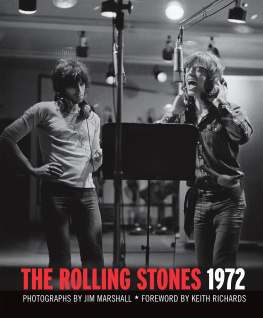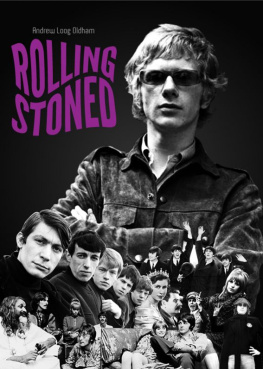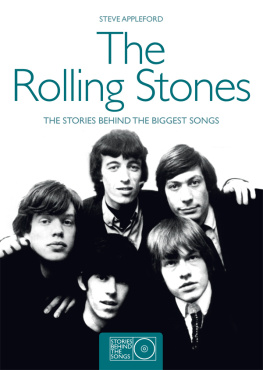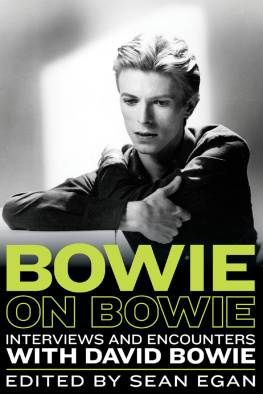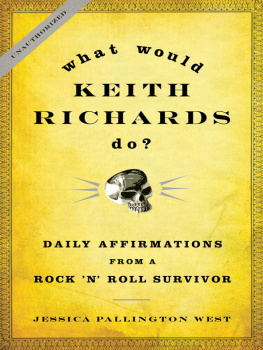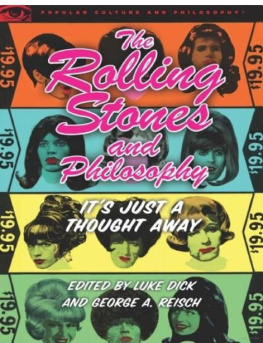O THER B OOKS IN THE M USICIANS INTHEIROWNWORDSSERIES
Coltrane on Coltrane: The John Coltrane Interviews
Hendrix on Hendrix: Interviews and Encounters with Jimi Hendrix
Miles on Miles: Interviews and Encounters with Miles Davis
Springsteen on Springsteen: Interviews, Speeches, and Encounters
Tom Waits on Tom Waits: Interviews and Encounters

Copyright 2013 by Sean Egan
All rights reserved
First edition
Published by Chicago Review Press, Incorporated
814 North Franklin Street
Chicago, Illinois 60610
ISBN 978-1-61374-788-9
Cover and interior design: Jonathan Hahn
Cover photograph: Paul Natkin
Library of Congress Cataloging-in-Publication Data
Keith Richards on Keith Richards : interviews and encounters / edited by Sean Egan. First edition.
pages cm
Includes index.
ISBN 978-1-61374-788-9 (trade paper)
1. Richards, Keith, 1943Interviews. 2. Rock musiciansEnglandInterviews.
3. Rolling Stones. I. Egan, Sean, editor. II. Richards, Keith, 1943-, interviewee.
ML420.R515A5 2013
782.42166092dc23
[B]
2013011878
Printed in the United States of America
5 4 3 2 1
CONTENTS
Index
INTRODUCTION
Whether it be The Human Riff, Mr. Rock n Roll, Keith Riff-hard, The Worlds Most Elegantly Wasted Human Being, or just Keef, his nicknames speak volumes about the affection held by the rock fraternity for the man who has been the joint most important member of the Rolling Stones for half a century.
In the Stones early years, Keith Richardsborn December 18, 1943was professionally known as Keith Richard and was unquestionably to the rear of both Stones singer Mick Jagger and fellow guitarist Brian Jones in terms of importance, renown, and prominence. The vocalist was naturally the focal point for both media and fans. Jones not only vied with Jagger for status of fan favorite courtesy of his golden good looks but was in demand from journalists impressed by his eloquence and gravitas-conveying posh tones. Nonetheless, that fan favorite principlethe notion that each member of a pop group possessed his own devoteesmeant that Richardss views always received at least a by-rotation exposure in the music press.
Richardss position equidistant between the glamour of Jagger and Jones and the semi-anonymity of Quiet Ones Charlie Watts (drums) and Bill Wyman (bass) began to shift in 1965 with the release of the Stones first self-generated UK single, The Last Time. Courtesy of the phenomenally successful songwriting partnership he developed with Jagger, Richards was transformed within months from merely one of hundreds of Western musicians purveying versions of other peoples songs to half of the second-most important songwriting partnership in the world. That Stones fare like (I Cant Get No) Satisfaction, Get Off of My Cloud, and Lets Spend the Night Together was not just aesthetically brilliant but the exquisite articulation of the grievances of a fractious young generation made Richards and his opinions sociologically significant. In 1967, Richards acquired a fame beyond the parameters of the pop business when a drug bust at his house Redlands andin the company of Jaggersubsequent trial and brief imprisonment catapulted him onto the front pages of British national newspapers.
Journalists increasingly began requesting quotes from the guitarist, genuinely keen to get his perspective rather than grumpily settling for it in lieu of Jaggers or Joness availability. Richards blossomed with his increasing importance, the taciturn, big-eared, acne-scarred ruffian of the early days transformed into a stylish physical symbol of the rebellious spirit of rock music. It wasnt all image either. Kicking an audience member in the face for spitting, punching a journalist in the jaw for suggesting the July 1969 Hyde Park concert was disrespectful to the memory of the just-deceased Jones, and squaring up to Hells Angels at the December 1969 Altamont festival suggested a man who walked it like he talked it. For all these reasons, by the early 1970s, wannabe rock stars and regional rebels across the world were imitating Richardss big belt buckles, trailing scarves, shark tooth necklace, mirrored shades, andespeciallytangled, shoulder-length mane of black hair.
When Richards made the front cover of Rolling Stone in August 1971, it served to confirm that he was now a counter-cultural icon as important as Jagger. As the 1970s wore on, he became more than even that. Jaggers hitherto unassailable position as scourge of the authoritarian establishment whose fusty values his generation sought to overthrow began to look increasingly suspect as he hobnobbed with the type of dignitaries and socialites with whom Richards wouldnt be seen dead. Meanwhile, thrillingly for some, Richards being seen dead became an increasingly likely prospect: knowledge of his heroin addiction was an open secret much discussed in the music papers, as well as in the mainstream press on the occasions of his frequent arrests. The outlaw image engendered by Richardss implicit defiance of the authorities and his tangoing with the Grim Reaper communicated to the rock audience a retention of anti-establishment integrity. Though that logic might have been confused, he at least provided a dramatic counterpoint in his druggie murk to Jaggers glitzy carryings-on. Richardss infamous 1977 Toronto drug bust ended that wasted lifestyle where the responsibility of raising two children and the trauma of the death of a third had not. Although the prospect of a life sentence for trafficking brought about his cleanup, Richards dines out on his smack decade to this day. It gave him a myth that Stones fans and journalists are more than happy to indulge and bolster. Richards, in turn, cooperates in the process by turning horror stories of addled irresponsibility into funny anecdotes. He may now be more or less law-abiding, but his outlaw aura will never die.
On one level, Richardss interviews have been what one would expect of a man with his image. His spurning of banality and rejection of euphemism were right in line with that no-nonsense rebel mien. Yet, other aspects of his character revealed by his increasingly frequent audiences with the press were surprising. Few journalists came away from a Richards interview without noting in print how warm and unpretentious was a man who one might more readily assume to be aloof, sinister, and self-regarding. Moreover, he was an unusually articulate and intelligent individual. Witness how the aforesaid 1971 Rolling Stone interview is speckled with comments that reveal a man steeped in the hardly rock n roll subject of history. He was also perennially honest, answering questions about sensitive subjects like band interrelations, the death of Brian Jones, and personal drug use with a degree of candor Jagger was too haughty (some would say sensible) to even entertain.
Richards is not always a reliable witness. Checking his versions of events against the known facts reveals that he tends to conflate or telescope incidents for reasons of poetry. This leads to such widely disseminated myths as the story of Stones manager Andrew Loog Oldham locking him and Jagger in a kitchen and not letting them out until theyd written their first song. Though the incident is not a complete fabrication, Jagger and Oldhams separate testimonies suggest that the reality was more mundane and elongated than Richardss recollection would have it. Moreover, as he has gotten older, the Richards persona has become encrusted with a submission to tabloid clich. From the early 1980s onward, he began playing up to his image of rock outlaw via stylized self-deprecation about his days as a bad boy and menace to society, something that has become embarrassingly pronounced in recent years, although no less so than his verbal usage of Americanisms like baby. However, his frankness continues to outweigh his posturing. This became an ever more important asset as the decades wore on: whereas Mick Jaggers interviews have become exercises in obfuscation and almost irritatingly sustained politesse, Richardss have remained likeable, open, and scathing about cant.
Next page


